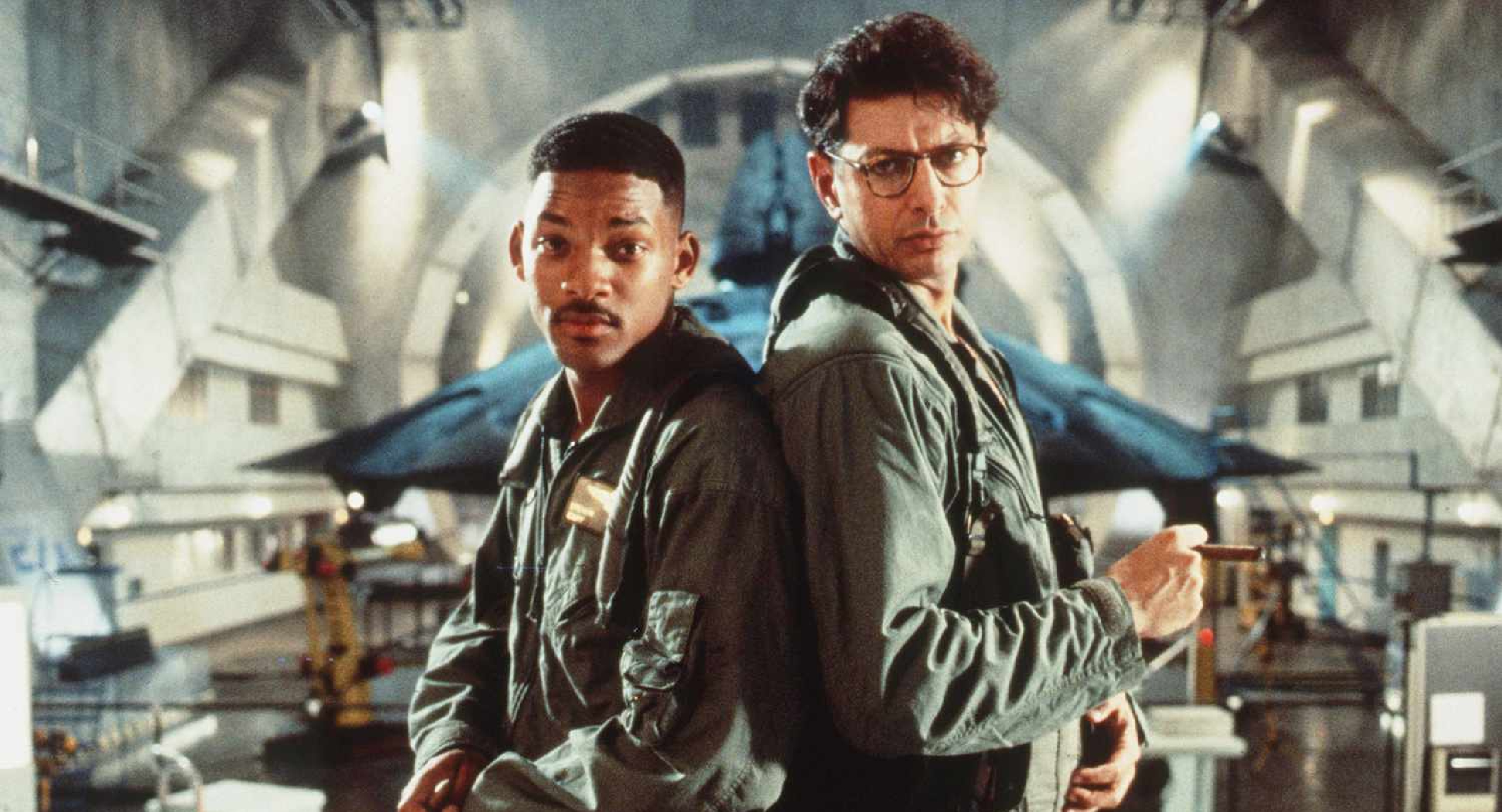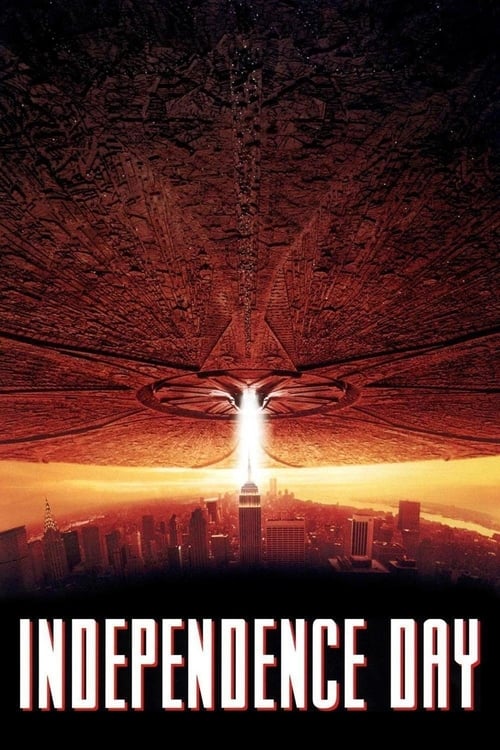Independence Day – Film Review
Published May 17, 2023

On July 2, a giant alien mothership enters orbit around Earth and deploys several dozen saucer-shaped ‘destroyer’ spacecraft that quickly lay waste to major cities around the planet. On July 3, the United States conducts a coordinated counterattack that fails. On July 4, a plan is devised to gain access to the interior of the alien mothership in space, in order to plant a nuclear missile.
Independence Day burst onto the silver screen in 1996 and quickly became a sensation. Known for its epic scale and gripping action sequences, the film has cemented its place in pop culture as a quintessential alien invasion blockbuster. While Independence Day certainly delivers on its promise of spectacle and thrills, it falls short in some areas, preventing it from reaching true greatness.
At the heart of Independence Day is an exhilarating premise: an advanced alien species arrives on Earth with intentions that are far from peaceful. As humanity rallies together in the face of imminent destruction, the film showcases a wide range of characters and perspectives. The ensemble cast, including Will Smith, Jeff Goldblum, Bill Pullman, and Vivica A. Fox, delivers commendable performances, injecting personality and depth into their respective roles.
One of the film’s biggest strengths lies in its jaw-dropping visual effects. Even after more than two decades, the CGI in Independence Day still holds up remarkably well. From the awe-inspiring shots of gigantic spaceships hovering over major cities to the explosive destruction they unleash, the visual spectacle is a feast for the eyes. The attention to detail in creating the alien technology and the destruction they wreak upon iconic landmarks is impressive and adds to the film’s immersive experience.
Roland Emmerich‘s skill in orchestrating large-scale action sequences is evident throughout the film. The intense aerial dogfights between human fighter jets and alien spacecraft are exhilarating and pulse-pounding, with the sound design further amplifying the sense of chaos and urgency. The film’s iconic scene of the White House being obliterated by a massive laser beam remains etched in the memories of moviegoers.
However, where Independence Day falters is in its characterization and storytelling. While the film attempts to weave multiple narrative threads together, it struggles to give each character enough development and depth. Will Smith’s Captain Steven Hiller, for example, is a charismatic and likable protagonist, but his journey feels somewhat formulaic and lacks the emotional depth required to make a lasting impact. Similarly, Jeff Goldblum’s David Levinson, the brilliant computer expert, never quite reaches his full potential, leaving viewers craving more substance.
The screenplay, penned by Dean Devlin and Roland Emmerich, tends to rely on clichés and contrivances, sacrificing genuine character moments for convenience. The dialogue often leans towards the cheesy and predictable, diluting the impact of some pivotal scenes. Moreover, the pacing can be uneven at times, with certain sections feeling rushed while others drag on, disrupting the overall flow of the narrative.
Independence Day is also not immune to the pitfall of excessive patriotism. While a certain degree of national pride is expected in a film titled Independence Day, it occasionally veers into heavy-handed territory, bordering on jingoism. The portrayal of the American military as the ultimate saviors, while disregarding the contributions of other nations, undermines the film’s potential for inclusivity and global unity.
In terms of thematic exploration, Independence Day touches on concepts such as resilience, unity, and the indomitable spirit of humanity. It presents a message of hope and the triumph of the human race in the face of overwhelming odds. However, these themes are not explored with enough depth or subtlety, resulting in a missed opportunity to add greater layers of meaning to the film.
All of this said, though, Independence Day remains a highly entertaining and visually stunning alien invasion extravaganza that has secured its place in cinematic history. Roland Emmerich’s talent for crafting grand-scale action sequences, coupled with the impressive visual effects, delivers a gripping movie experience. However, the film falls short in terms of character development, storytelling, and thematic depth. The lack of fully fleshed-out characters and reliance on clichés diminish the emotional impact of the narrative, while the uneven pacing disrupts the overall flow. Additionally, the film occasionally indulges in excessive patriotism, undermining its potential for inclusivity and global unity.
Despite these flaws, Independence Day is undeniably a thrilling popcorn flick that offers a visual spectacle that stands the test of time. The CGI effects remain impressive even by today’s standards, and the action sequences, particularly the aerial dogfights, are pulse-pounding and exhilarating. The destruction of iconic landmarks and the White House scene in particular have become iconic moments in cinema history.
The ensemble cast, led by Will Smith, Jeff Goldblum, Bill Pullman, and Vivica A. Fox, deliver solid performances, injecting some personality into their respective roles. Will Smith’s charismatic presence and comedic timing bring levity to the film, while Jeff Goldblum’s nerdy brilliance adds an intellectual element to the proceedings. Bill Pullman’s portrayal of the President showcases moments of inspirational leadership, albeit limited by the screenplay’s constraints.
Independence Day succeeds in capturing a sense of global catastrophe and the urgency of humanity’s struggle against a formidable alien threat. The film’s core themes of resilience, unity, and the indomitable spirit of humanity resonate on a basic level, but their exploration is surface-level at best. The missed opportunity to delve deeper into these themes prevents the film from reaching its full potential and elevating it beyond a typical summer blockbuster.
Furthermore, the screenplay suffers from contrivances and predictable dialogue that hinder the impact of key scenes. While the film boasts some memorable one-liners, they often lean towards the cheesy and do little to add depth or nuance to the characters or their relationships. The lack of genuine emotional moments prevents the audience from fully investing in the stakes of the story.
Another drawback of Independence Day is its portrayal of other nations in the face of the alien invasion. While it is expected that the film would emphasize the role of the American military and its heroes, the near-absence of significant contributions from other countries feels like a missed opportunity for a more inclusive and diverse representation. The heavy-handed patriotism, particularly in the third act, narrows the film’s scope and diminishes its potential impact on a global scale.
Despite its flaws, Independence Day remains a classic example of a big-budget, popcorn-munching blockbuster. Its impressive visual effects, exhilarating action sequences, and charismatic performances make it an enjoyable watch. However, the lack of depth in characterization, storytelling, and thematic exploration prevent it from transcending its status as a visually stunning, yet ultimately shallow, alien invasion film.
While Independence Day falls short of achieving true greatness due to its shortcomings in character development, storytelling, and thematic depth, it still manages to entertain and captivate with its grand-scale spectacle and thrilling action. It remains a significant entry in the sci-fi genre and a nostalgic reminder of the summer blockbusters of the 1990s.
